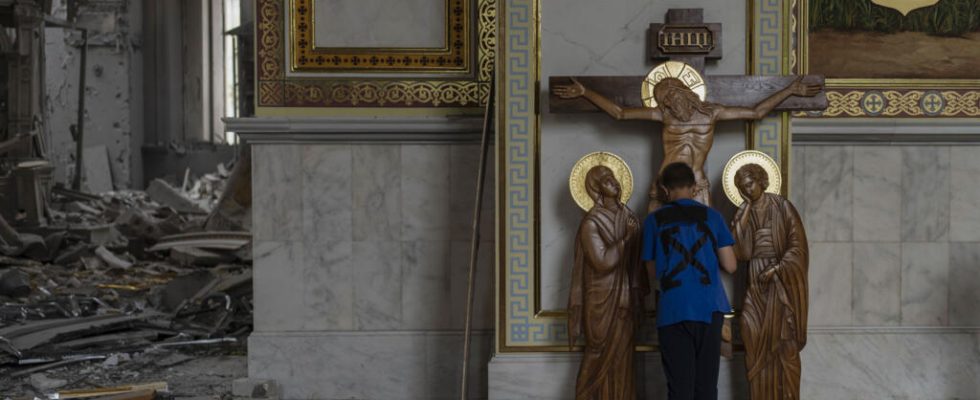The city of Odessa, Ukraine, is still struggling to recover from the missile strike that hit its heart on Sunday night July 23. The Russian navy sent a number of ballistic missiles to the city, which fell on port infrastructure, but also – something new – in the heart of the old town, a UNESCO World Heritage Site, destroying the main cathedral of the place.
3 mins
With our special envoy back from Odessa, Stephane Siohan
Bruised, Odessa heals its wounds. What marks the most in this city is the dust and this slightly crazy wind from the Black Sea, which carries and projects into the eyes all these particles of limestone, resulting from the total or partial destruction of no less than 209 buildings last weekend.
The weather was nice this Tuesday in Odessa, but Odessa has the blues, and that, you can feel it especially in the porch of the Cathedral of the Transfiguration, this monument in the city center, on one of the main streets, which was partially destroyed by a direct missile strike.
All day, parishioners and onlookers throng the south porch, spared. And they come to put candles on an improvised hotel, looking at the interior of the devastated cathedral, its gutted walls, its open roof and these stones or these sheets which crash on the marble in a huge crash, while workers secure the site.
Odessa is, with Lviv, the only Ukrainian city whose city center is entirely classified by Unesco, and no less than 28 buildings classified as historical monuments have been totally or partially destroyed.
Touching moment with Daryna, a university law professor, who came to help clear the House of Scientists, an old 19th century urban mansion popular with researchers – the very place where she had presented her thesis on international law a few years ago.
Barbarian invasion. Odesa House of Scientists. July 23, 2023. My heart aches so much. This place was like a second home. pic.twitter.com/UgPxZRWmao
— volodymyr dubovyk (@VolodymDubovyk) July 23, 2023
19 missiles hit Odessa last night, one of them destroyed the Transfiguration Cathedral, one of the main monuments of the (magnificent) city whose center is classified as a UNESCO monument in danger pic.twitter.com/Sa0fq2zgTk
— Stephane Siohan (@stefsiohan) July 23, 2023
Elsewhere in the city, wanted and built by the Russian Empire two centuries ago, entire buildings have been devastated. Excavators clear streets and backyards of old buildings often dating back to the 19th century.
Fortunately, if one can say so, the inhabitants had rather well respected the alerts. Many had taken refuge in cellars and underground passages. Considering the scale of the destruction, the toll is miraculously low: only two dead counted, and around twenty wounded.
What is the logic of this bombardment? What appears is that the Russians and their navy wanted to hit the port facilities, the silos, below the city. Missiles were thus lost on old buildings overlooking the seafront.
As for the Cathedral of the Transfiguration, one of the priests met on the spot is sure and certain that the attack was deliberate, even though the church belongs to the Ukrainian Orthodox Church, historically linked to the Moscow Patriarchate.
The objective is to punish Odessa, to bring it to its knees, to paralyze its grain trade, and the trade of its port, which is the economic lung of the city.
Only, the Russians, who consider Odessa as a Russian city, are guilty of absolutely counterproductive crimes. The beautiful city of Odessa, so proud of its influence, has always assumed its share of Russian cultural heritage, living under the illusion that the Russians, who desire it so much, would not strike it.
This bubble of trust has burst, the awakening is brutal and painful. Many Odessites now only feel a cold hatred for Russia and the desire to put an end to this sick fantasy of a lost empire.
Read alsoWar in Ukraine: Unesco condemns “brutal Russian strikes” against the heritage of Odessa
